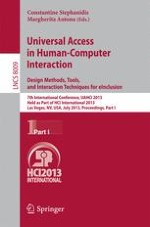The three-volume set LNCS 8009-8011 constitutes the refereed proceedings of the 7th International Conference on Universal Access in Human-Computer Interaction, UAHCI 2013, held as part of the 15th International Conference on Human-Computer Interaction, HCII 2013, held in Las Vegas, USA in July 2013, jointly with 12 other thematically similar conferences.
The total of 1666 papers and 303 posters presented at the HCII 2013 conferences was carefully reviewed and selected from 5210 submissions. These papers address the latest research and development efforts and highlight the human aspects of design and use of computing systems. The papers accepted for presentation thoroughly cover the entire field of human-computer interaction, addressing major advances in knowledge and effective use of computers in a variety of application areas.
The total of 230 contributions included in the UAHCI proceedings were carefully reviewed and selected for inclusion in this three-volume set. The 74 papers included in this volume are organized in the following topical sections: design for all methods, techniques and tools; eInclusion practice; universal access to the built environment; multi-sensory and multimodal interfaces; brain-computer interfaces.
